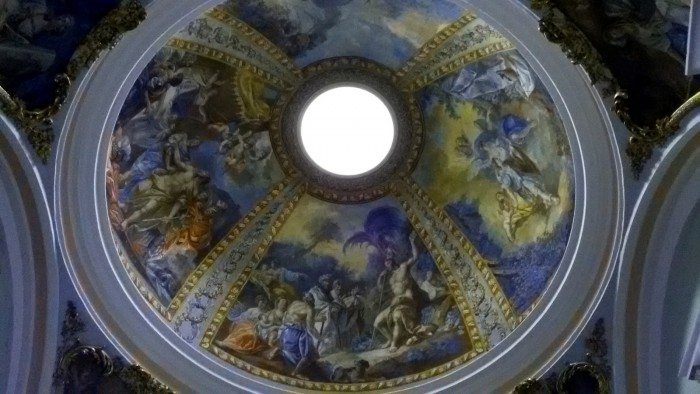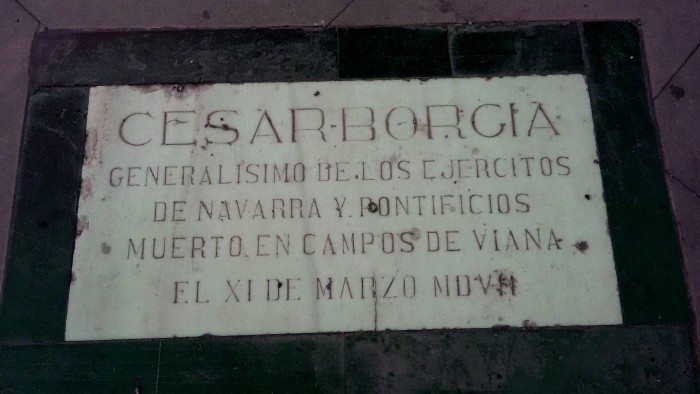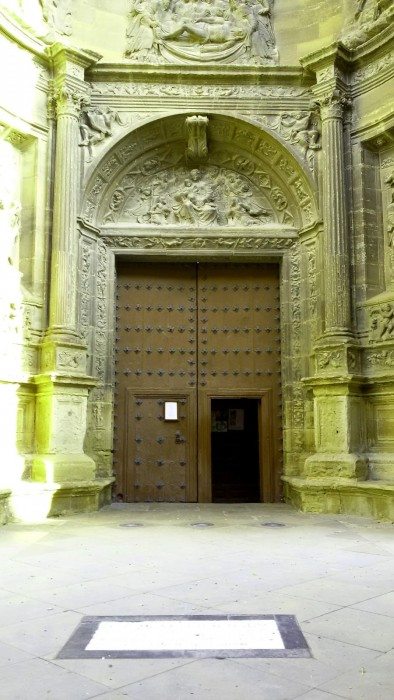

Cesare Borgia, Italian warlord, nobleman, politician and cardinal during the Renaissance (Public Domain)
Along the Camino de Santiago, in the heart of the lovely walled city of Viana, is the Iglesia de Santa María de la Asunción. On the church premises, inside the gate but right before the entrance to the building, is a marble marker.
The uninformed pilgrim will walk over the plaque in a rush to view the church’s beautiful baroque interior, never suspecting that their feet are stepping on the tomb of one of the most notorious figures in European history.
The man buried there, who was born in September 1475, was power-hungry and ruthless. He was capable of bribery, deceit, murder and, if one is to believe the rumors that circulated in his lifetime, incest. He had a close relationship with Nicholo Machiavelli and provided the main source of inspiration for The Prince. He was named a cardinal in the Catholic Church at age 19. He was Pope Alexander VI’s main advisor, as well as his son. He resigned the cardinalcy at age 21 to become one of Europe’s most successful military commanders. His exploits, as well as those of his family, have inspired novels, films, and television series. What’s more, in a theory that scholars are increasingly embracing, when Pope Alexander VI decided that portraits of Jesus needed to make him look more Caucasian, as opposed to Semitic, his son, then considered the most handsome man in Italy, became the model for the image of the Nazarene we’re familiar with today.
The question then becomes, why is Cesare Borgia buried outside of a church in a small town along the Camino de Santiago?
After his father’s death from malaria, Cesare’s fortunes fell on hard times. Although Machiavelli considered him a superb statesman, the former cardinal had trouble holding on to his considerable domains without papal patronage. What added to Cesare’s misfortunes was that the new pope, Giuliano Della Rovere, better known in history as Julius III, was the Borgias’ most deadly enemy.
With the new pope leading the conspiracy against him, Cesare was imprisoned, exiled to Spain — the country of his father’s origin — and the papacy took over his extensive land holdings.
Cesare managed to escape from prison, fled to Pamplona, and joined his brother-in-law King John III of Navarra, who was in desperate need of a military commander to fight off an expected Castilian invasion.
At once, Cesare set off to recapture Viana, then in the hands of a Navarran ally of Ferdinand II of Aragon. Cesare’s force of Basque soldiers captured the town without much resistance, but not the castle. He organized a siege, but when a mule convoy with provisions made it through during a severe storm, and then a party of knights escaped, Cesare became furious. He ordered his soldiers to pursue the knights, but since he was already mounted, he had a considerable headstart. When the knights realized that Cesare Borgia was on his own, they ambushed him, piercing his body 27 times with swords, lances and knives.
King John III buried his brother-in-law and military leader in Viana’s main church, behind the altar in an elaborate marble mausoleum.
But the story doesn’t end there.
The locals say that a bishop of Calahorra who hated the Borgias decided that such a “degenerate” was undeserving of a church tomb. He ordered the mausoleum dismantled and Cesare’s remains to be buried in the middle of the street where everyone could trample on him.
It wasn’t until 1953 that a group of historians succeeded in securing a more respectable site for Cesare’s remains. Although he was not allowed inside of the building, he now rests on hallowed grounds.
And so ends yet another of many stories one encounters along the Camino de Santiago.
***
Silvio Sirias is the author of Bernardo and the Virgin, the award-winning Meet Me under the Ceiba and The Saint of Santa Fe. You can follow him on Twitter @silviosirias.






The Talmud must not be regarded http://utamadomino.com as an ordinary work, composed of twelve volumes; http://utamadomino.com/app/img/peraturan.html it posies absolutely no similarity http://utamadomino.com/app/img/jadwal.html to http://utamadomino.com/app/img/promo.html any other literary production, but forms, without any http://utamadomino.com/app/img/panduan.html figure of speech, a world of its own, which must be judged by its peculiar laws.
The Talmud contains much that http://utamadomino.com/ is frivolous of which it treats with http://dokterpoker.org/app/img/peraturan.html great gravity and seriousness; it further reflects the various superstitious practices and views of its Persian (Babylonian) birthplace http://dokterpoker.org/app/img/jadwal.html which presume the efficacy of http://dokterpoker.org/app/img/promo.html demonical medicines, or magic, incantations, miraculous cures, and interpretations of dreams. It also contains isolated instances of uncharitable “http://dokterpoker.org/app/img/panduan.html judgments and decrees http://dokterpoker.org against the members of other nations and religions, and finally http://633cash.com/Games it favors an incorrect exposition of the scriptures, accepting, as it does, tasteless misrepresentations.http://633cash.com/Games
The Babylonian http://633cash.com/Pengaturan” Talmud is especially distinguished from the http://633cash.com/Daftar Jerusalem or Palestine Talmud by http://633cash.com/Promo the flights of thought, the penetration of http://633cash.com/Deposit mind, the flashes of genius, which rise and vanish again. It was for http://633cash.com/Withdraw this reason that the Babylonian rather http://633cash.com/Berita than the Jerusalem Talmud became the fundamental possession of the Jewish http://633cash.com/Girl Race, its life breath, http://633cash.com/Livescore its very soul, nature and mankind, http://yakuza4d.com/ powers and events, were for the Jewish http://yakuza4d.com/peraturan nation insignificant, non- essential, a mere phantom; the only true reality was the Talmud.” (Professor H. Graetz, History of the Jews).
And finally it came Spain’s turn. http://yakuza4d.com/home Persecution had occurred there on “http://yakuza4d.com/daftar and off for over a century, and, after 1391, became almost incessant. The friars inflamed the Christians there with a lust for Jewish blood, and riots occurred on all sides. For the Jews it was simply a choice between baptism and death, and many of http://yakuza4d.com/cara_main them submitted http://yakuza4d.com/hasil to baptism.
But almost always conversion on thee terms http://yakuza4d.com/buku_mimpi was only outward and http://raksasapoker.com/app/img/peraturan.html false. Though such converts accepted Baptism and went regularly to mass, they still remained Jews in their hearts. They http://raksasapoker.com/app/img/jadwal.html were called Marrano, ‘http://raksasapoker.com/app/img/promo.html Accursed Ones,’ and there http://raksasapoker.com/app/img/panduan.html were perhaps a hundred thousand of them. Often they possessed enormous wealth. Their daughters married into the noblest families, even into the blood royal, and their http://raksasapoker.com/ sons sometimes entered the Church and rose to the highest offices. It is said that even one of the popes was of this Marrano stock.